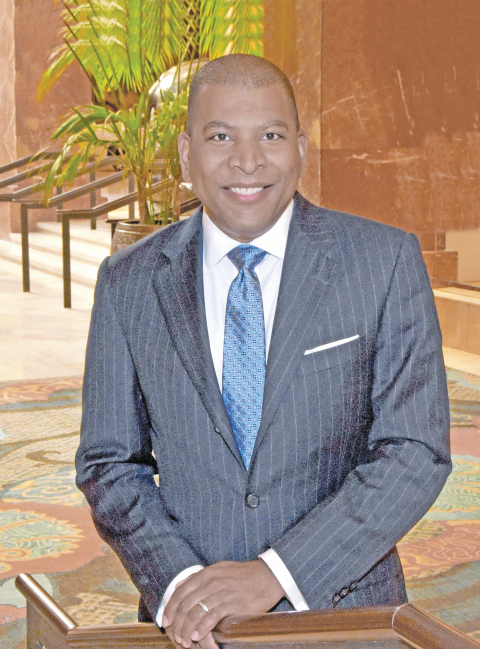A seat at the table
BP’s Ray Dempsey talks strategy to help achieve diversity goals.
By Melissa Lowery

When Ray Dempsey graduated with an engineering degree from Kansas State University in 1990, he received job offers in several industries. But, he wasn’t looking for a job — he was looking for a meaningful, challenging career.
“I wanted to go somewhere where I felt there would be a breadth of opportunity and a breadth of challenge that would endure. It wasn’t just about taking a job, I wanted to position myself for an adventure,” he said. “On reflection, I don’t think I could have made a better choice. The energy industry has been an exciting and challenging space for a long time.”
Dempsey found what he was looking for in Amoco Corp., the oil and petrochemical giant. He has been with the company ever since, through the merger with The British Petroleum Co. PLC in 1999 and the ultimate rebranding as BP PLC.
Over the years, he held several positions in both the United States and London, where BP is headquartered. From engineer to corporate manager to vice president — for nearly three decades, he has helped shape the company’s strategy and identity, leading both external relationships and internal teams. In early 2017, he took on the newly empowered roles of BP chief diversity officer and president of BP Foundation Inc.
Empowering diversity
Although BP had a longstanding supplier diversity program and a robust diversity and inclusion effort within its workforce strategies, the two programs were separate. Dempsey recognized that by combining the two, the company could radically increase buy-in toward reaching diversity goals.
“I made the argument that we could create a lot more power and traction in shaping our identity and reputation internally and externally, if we linked the things we do to drive our workforce diversity to all the things we do in supplier diversity and in the community around us,” he said.
Dempsey is making big moves as the new CDO, now a truly C-suite level position. One focus is increasing the number of women’s business enterprises in BP’s supply chain, despite a period of slower growth within the industry.
“Even as we’ve gone through a very lean time in our industry — with an extended period of low crude oil prices — we’ve managed to grow our spend with WBEs,” he said. “That’s great progress. And, we feel good about it, but we’re not content. We’re looking to drive more progress this year on our way toward — we hope — a seat at the Billion Dollar Roundtable.”
Reaching out to women-owned businesses
To achieve that auspicious billion-dollar goal, Dempsey is working closely with the Women’s Business Enterprise National Council and other leaders in the industry. He serves as chair of the WBENC Energy Industry Advisory Board, a group made up of supplier diversity leaders from BP, ExxonMobil, Chevron, ConocoPhillips and Shell.
“We started the EIAB because all of us in the industry have an interest in growing the participation of WBEs in our supply chains,” he said. “While we’ve all had varying degrees of success, we were all facing a similar challenge: the need to increase the overall understanding of our industry among WBEs. We decided to work together toward this shared goal. Of course, we continue to compete in the marketplace generally. But, in service of increasing the number of WBEs that are ready and qualified to do business with any of us, we thought that was worth working together.”
This collaboration has produced a pair of significant outcomes. The inaugural WBENC Energy Executive Program took place in November 2017. The EEP is a weeklong immersive experience focused on increasing the competitive advantage and capabilities of women leaders within the energy, oil and gas industry supply chains.
A group of 30 women business owners assembled at Shell’s Training and Conference Center in Robert, Louisiana, for a week of training, skills development and networking. Faculty included executives and academics who spent focused time together talking about how the energy sector really works and how WBEs can better prepare to do business within the industry. The second EEP is scheduled for Oct. 28 – Nov. 2, 2018.
“Our hope is that the businesses and the women who run them will go away with a deeper understanding of the steps they need to take to be prepared to do business in our industry,” Dempsey said.
While the EEP brings women business owners to the industry, the Energy Pavilion brings the industry to WBEs. Another collaborative effort from the EIAB, it debuted at WBENC’s national conference in June 2017.
For many years, energy companies participating in the WBENC annual business fair had individual booths and tried not to be close to one another in order to get the focused attention of WBEs. The advisory board realized that approach might be undermining its overall efforts and conceived a new strategy. The Energy Pavilion now houses industry members and prime contractors in one area, providing information about the overall industry and how WBEs might fit into the supply chain. There is even a giant model pipeline hanging above the area, enabling WBEs to spot the Energy Pavilion as soon as they enter the business fair.
“It’s a powerful way to say, ‘We’re not just individual companies, but we’re the energy industry. And, we’re serious about finding ways to do business with you,’” Dempsey said.
The future of energy
Nearly 30 years into his career, he is still excited by the opportunities and challenges inherent in the energy industry. Whether it’s finding cleaner ways to meet the demand for hydrocarbon energy or innovating renewable, sustainable energy sources, he is looking forward to how diverse suppliers will play a bigger part in our energy future.
“At BP, we recognize a dual challenge of meeting growing global demand for energy — especially in places like China and India where demand is growing rapidly — while reducing greenhouse gas emissions in support of advancing a lower-carbon future,” Dempsey said. BP is investing in alternative energy sources like solar, wind energy and biofuels with an eye toward the future.
Diverse suppliers can play a key role in the future of energy, but first they must know that the opportunities exist and how they can participate.
“It’s an exciting time in the energy industry,” he said. “There are a lot of opportunities for new suppliers to help us solve the world’s energy challenges, and that is why our partnership with WBENC is so critical. Our participation in the EIAB and the programming we are developing is an important priority and will help us to reach our goal to do more business with WBEs.”
To help BP America Inc. reach its supplier diversity goals, Chief Diversity Officer Ray Dempsey is working closely with the Women’s Business Enterprise National Council and serves as chair of the WBENC Energy Industry Advisory Board. Members of the board are (from left): Norman LeBlanc, ConocoPhillips; Lindsey All, WBENC; Joanne Jordan, Exxon Mobil Corp.; David Feldman, Chevron Corp.; Doug Fisher, ExxonMobil; Dempsey; Tami Hunter, ConocoPhillips; Brenda Erickson, ConocoPhillips; Brian Hall, Shell Oil Co.; Debra Jennings-Johnson, BP America; and Phala Mire, Women’s Business Enterprise Council – South.




Leave A Comment